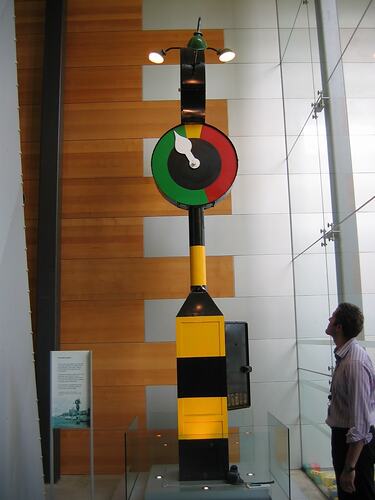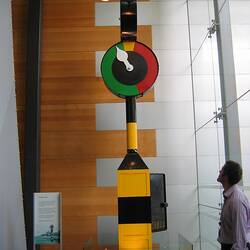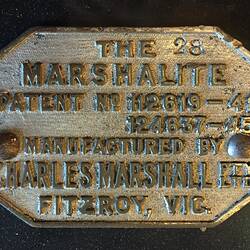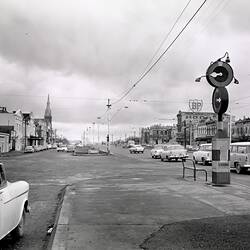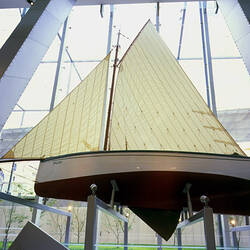Summary
Clockface type traffic control signal, designed by Charles Marshall in 1936-37 and manufactured by his manufacturing engineering firm Charles Marshall Pty Ltd, of Fitzroy. This type of signal was used at about 35 Melbourne intersections between the late 1930s and the 1960s. The signal has two large discs, each approximately 3-ft (1 metre) in diameter set at right angles at the top of a 15-ft (4.57 metre) high mast with dial faces on either side of each disc designed to face the oncoming traffic on all four roads at a right-angle crossroad intersection. A large white indicator hand or pointer on each the dial face swept through red, yellow and green sectors of the face to indicate stop and go intervals.
The prototype Marshalite unit was installed at the intersection of Gertrude Street and Brunswick Street, Fitzroy, in 1937, at the expense of the company with the permission of the Fitzroy City Council. It lasted only a short period before having to be dismantled after falling foul of the law. A Fitzroy councillor who had been booked for driving against the signals contested his fine in court and won on the grounds that the signals were not the property of the Fitzroy Council and therefore were operating without legal jurisdiction and so where ordered to be removed. The Second World War then intervened hampering further development and it was not until 1945 that a second example was installed (with appropriate approvals) on the corner of Johnson and Brunswick Streets, Fitzroy. Over the next 15 years a number of Marshalite signals were installed at main road intersections in Fitzroy, Clifton Hill, Northcote, Coburg, Richmond, Malvern, Camberwell and along the Neapan Highway through Chelsea. Originally the dials on the Marshalite signals had only green and red sectors, with a rotating indicator lamp instead of the pointer, but later an orange or amber sector was later added at the request of the Traffic Police to give motorists approaching the intersection at speed a warning of the impending change from green to red, and a plain white pointer was used instead of the rotating lamp, with the whole dial illuminated by an overhead lamp at night. Contrary to popular misconception, Marshalite signals always operated in conjuction with more conventional traffic lights positioned on each corner of the intersection, which were connected as slave signals controlled by the operation of the master Marshalite signal, which stood on either in the centre of the intersection or on the most prominent corner. Initially these traffic lights had only two lamps showing green and red, with a third amber lamp added when the intermediate colour was also added to the Marshalite dials.
The Museum's Marshalite was donated in 1973 by the Eagle Signal Co. in poor condition. It was restored to operating condition and repainted in 1991 for use in the first Scienceworks exhibition. It is now displayed at Melbourne Museum.
Physical Description
Tall metal stand supporting large dial with two faces. Both stand and faces are painted. The mechanism inside the stand causes the hands on the faces of the dial to rotate. On the top of the signal are four arms which extend outwards in front of the faces, holding lamps which illuminated the dials at night.
More Information
-
Collecting Areas
-
Acquisition Information
Donation from Eagle Signal Company Australia Pty Ltd, Sep 1973
-
Maker
Charles Marshall Pty Ltd, 44 Brunswick Street, Fitzroy, Greater Melbourne, Victoria, Australia, 1938-1950
-
Restorer
Mr Tom Myers - Vivian Expositions Co. (Vic.) Pty Ltd, 377 Gore Street, Fitzroy, Greater Melbourne, Victoria, Australia, 1990-1991
The traffic signal was restored to operating condition and repainted in original colours by Tom Myers of Vivian Expositions, Fitzroy, prior to it going on display in the original exhibitions at Scienceworks in March 1992. -
Brand Names
-
Classification
Road transport, Traffic management & safety, Traffic signals
-
Category
-
Discipline
-
Type of item
-
Overall Dimensions
1550 mm (Width), 4800 mm (Height)
METAL BASE PLATE MEASURES 96.0 x 96.0 (cm)
-
Exhibition Collection Management
2400 mm (Length), 1200 mm (Width), 4800 mm (Height)
measurement of base is 795 x 795
-
References
The Argus, 12 Jul 1954, p.13, 'The Red Turned Against Them', [Link 1]
-
Keywords
Marshalite, Traffic Controls, Traffic Control Signals, Inventions, Innovation & Design
